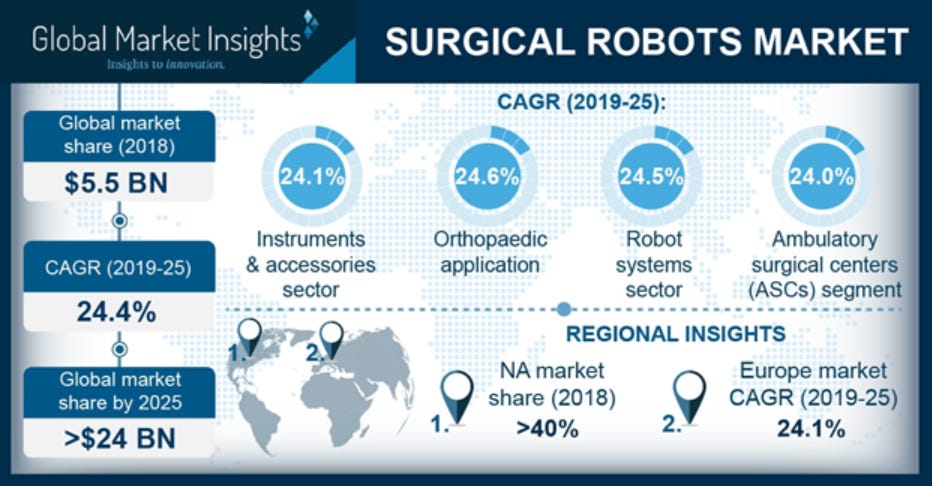Robots have been used to assist surgeons during surgery for several years now. However with the advances in robotics this field will undergo massive growth in the coming years. Global Market Insights estimates that the market for surgical robots will reach US$24Billion by 2025. Precision robots are able to make minimally invasive surgeries a reality and are being increasingly used in the fields of urology, gynecology, oncology, gastroenterology, thyroid, bariatric, colon and rectal surgeries.

Mako Surgical, a Michigan based orthopedic device company recorded nearly 76,900 knee and hip replacement procedures in 2018 with 650 Mako robots placed around the world. Da Vinci, developed by robotic surgery company Intuitive Surgical, completed 5 million surgeries in 2018 through the more than 4,500 surgical robots sold by the company worldwide.
Most of the large medical device companies are investing heavily in the development of robots that can assist with surgery.
New Robots in 2019
PRECEYES
Surgeons must have steady hands, especially when dealing with delicate areas such as the eyes. The University of Oxford has conducted a trial of PRECEYES Surgical System. The test involved 12 patients who needed membranes removed from their eyes or had a buildup of blood underneath the retina due to age-related macular degeneration. Half of the people got conventional procedures, while the others received robotic surgeries.

All the surgeries were successful, but the robotic approach was at least as successful and was sometimes even more effective than doing the procedures manually. There are also plans to use the surgical robots to dispense gene therapy to the retina.
The CorParth System
The CorPath System allows surgeons to practice in the virtual world before there’s a patient on the operating table, which is helpful for complicated procedures. Sometimes, VR combines with haptics to help users get tactile feedback that brings more realism to these practice sessions.

In addition to enabling doctors to get on-site training, the CorPath System from Corindus Vascular Robotics allows for remote surgery. Recently in India a surgeon performed stent insertion procedures on 5 patients, 30 kilometers away. This development presents significant benefits for people living in remote areas and for those that are not able to be transported to hospitals with expert surgeons (usually for medical reasons).
The Monarch Platform
Developed by Auris Health Inc., the Monarch is a surgical robotics platform that incorporates flexible robotics, micro-instrumentation, data science, and other technologies for therapeutic and diagnostic bronchoscopic procedures. Monarch aims to be the first robotic endoscopic platform to serve multiple disease states for both diagnostic and therapeutic intervention. The company’s primary disease target is Lung Cancer.
The Mako Rio
The Mako Rio, currently used for knee surgery and soon for hip surgery, makes a 3D model of the procedure based on the patient’s CT scan and provides real-time feedback as the surgeons use specialty instruments. Operations on the hips and knees require surgeons to carefully place implants inside the patients to help them eventually regain mobility.

The 3D modeling component also allows surgeons to plan each stage of the surgery before it happens. This could help them review approaches in it more ways than they could otherwise.
The Versius
The U.K.’s National Health System has said the Versius, considered a direct competitor to the da Vinci system, could improve care for patients and plans to use it next year following a European health and safety approval. CMR Surgical’s Versius, like other surgical robots, performs laparoscopic surgeries, also known as keyhole procedures.
A surgeon needs approximately 80 hours of training to learn the manual method of laparoscopic suturing. However, they can learn it in about a half hour when doing the technique with the Versius. The robot mimics the human arm and is designed to be easy to move between operating rooms.
Surgical Robots don’t replace Surgeons
Despite the rapid development of technology, surgeons don’t need to worry about robots taking over their jobs. Robots help reduce surgical errors and surgeon fatigue.
Even in the case of the remote surgery mentioned above, humans are always guiding the surgical robots and specifying what actions they take. Their decision-making expertise is still essential to successful care.
Paying it Forward
If you have a start-up or know of a start-up that has a product, ready for market please let me know. I would be happy to have a look and give the start-up a shout out to my readers if it is something that I think they could use. If you have any questions or comments please email me via my website craigcarlyon.com
Till next week.


